Articolo pubblicato dal sito ufficiale del Vaticano raggiungibile CLICCANDO QUI
ORIGINS OF CATACOMBS
History of the Catacombs
In the first century Rome's Christians did not have their own cemeteries.If they owned land, they buried their relatives there, otherwise they resorted to common cemeteries, where pagans too were buried. That is how Saint Peter came to be buried in the great public "necropolis" ("city of the dead") on Vatican Hill, available to everybody. Likewise Saint Paul was buried in a necropolis along the Via Ostiense.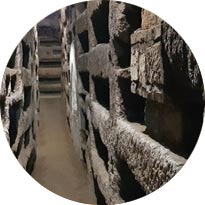
Gallery - Area A
© Pontificia Commissionedi Archeologia Sacra
In the first half of the second century, as a result of various grants and donations, the Christians started burying their dead underground. That is how the catacombs were founded. Many of them began and developed around family tombs, whose owners, newly converted Christians, did not reserve them to the members of the family, but opened them to their brethren in the faith. With the passage of time, these burial areas grew larger by gifts or by the purchase of new properties, sometimes on the initiative of the Church itself. Typical is the case of Saint Callixtus: the Church took up directly the organization and administration of the cemetery, assuming a community character.
With the edict of Milan, promulgated by the emperors Constantine and Licinius in February 313, the Christians were no longer persecuted. They were free to profess their faith, to have places of worship and to build churches both inside and outside the city, and to buy plots of land, without fear of confiscation. Nevertheless, the catacombs continued to function as regular cemeteries until the beginning of the fifth century, when the Church returned to bury exclusively above ground or in the basilicas dedicated to important martyrs.
When the barbarians (Goths and Longobards) invaded Italy and came down to Rome,they systematically destroyed a lot of monuments and sacked many places, including the catacombs. Powerless in the face of such repeated pillages, towards the end of the eighth century and the beginning of the ninth, the Popes ordered to remove the relics of the martyrs and of the saints to the city churches, for security reasons.
When the transfer of the relics was completed, the catacombs were no longer visited; on the contrary, they were totally abandoned, with the exception of Saint Sebastian, Saint Lawrence and of Saint Pancratius. In the course of time, landslides and vegetation obstructed and hide the entrances to the other catacombs, so that the very traces of their existence were lost. During the late Middle Ages they didn't even know where they were.
The exploration and scientific study of the catacombs started, centuries later, with Antonio Bosio (1575-1629), nicknamed the "Columbus of subterranean Rome". In the last century the systematic exploration of the catacombs, and in particular of those of Saint Callixtus, was carried out by Giovanni Battista de Rossi (1822-1894), who is considered the father and founder of Christian Archaeology.
SYMBOLS
The symbols
The early Christians lived in a mainly pagan and hostile society. During Nero's persecution (64 A.D.) their religion was considered "a strange and illegal superstition". The Christians were mistrusted and kept aloof, they were suspected and accused of the worst crimes. They were persecuted, imprisoned, sentenced to exile or condemned to death. Unable to profess their faith openly, the Christians made use of symbols, which they depicted on the walls of the catacombs and, more often, carved them on the marble-slabs which sealed the tombs.Like the ancient, the Christians were very fond of symbolism. The symbols were a visible reminder of their faith. The term "symbol" refers to a concrete sign or figure, which, according to the author's intention, recalls an idea or a spiritual reality. The main symbols are: the Good Shepherd, the "Orante", the monogram of Christ and the fish.
The Good Shepherd with a lamb around his shoulders represents Christ and the soul which He has saved. This symbol is often found in the frescoes, in the reliefs of the sarcophagi, in the statues and is often engraved on the tombs.
The "orante": this praying figure with open arms symbolizes the soul which lives in divine peace.
The monogram of Christ is formed by interlacing two letters of the Greek alphabet: X (chi) and P (ro), which are the first two letters of the Greek word "Christòs" or Christ. When this monogram was placed on a tombstone, it meant a Christian was buried there.
The fish. In Greek one says IXTHYS (ichtùs). Placed vertically, the letters of this word form an acrostic: Iesùs Christòs Theòu Uiòs Sotèr = Jesus Christ, Son of God, Saviour. Acrostic is Greek word which means the first letter of every line or paragraph. The fish is a widespread symbol of Christ, a motto and a compendium of the Christian faith.
Some other symbols are the dove, the Alpha and the Omega, the anchor, the phoenix, etc.
The dove holding an olive branch symbolizes the soul that reached divine peace.
The Alpha and the Omega are the first and the last letters of the Greek alphabet. They signify that Christ is the beginning and the end of all things.
The anchor is the symbol of salvation and of the soul which has peacefully reached the port of eternity.
The phoenix, the mythical Arabian bird, which, according to the beliefs of the ancient, after a thousand years arises from its ashes, is the symbol of the resurrection of the bodies.
The martyrs' tombs, the cubicles and also the arcosoliums could be at times decorated with pictures painted with the method of the fresco. The frescoes represent biblical scenes of the Old and the New Testament, some of them with a precise symbolic meaning.
The symbols and the frescoes form a miniature Gospel, a summary of the Christian faith.
CATACOMBS
OF ST. CALLIXTUS
Via Appia Antica, 110 – 00179 ROME Phone: +39 06.51.30.151 / +39 06.51.30.15.80; Fax: +39 06.51.30.15.67 scallisto@catacombe.roma.it www.catacombe.roma.it Director: Don Alojzij Dobravec, SDB Closed Wednesdays Closed in February Bus ATAC: 118, 218 |
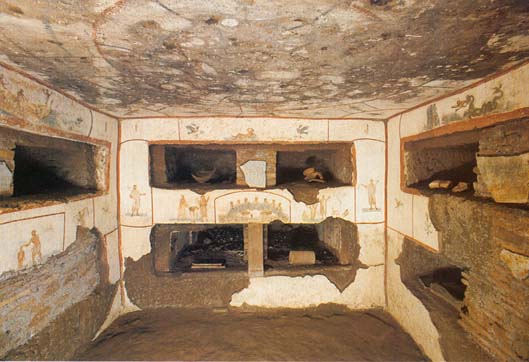
The St. Callixtus complex,
between the second and third mile of the ancient Appian Way, is made up by
above ground cemetery areas with annexed hypogea that can be dated to the end
of the second century A.D. These were originally independent from one another
and were later connected to form one vast network of community catacombs. The
complex owes its name to the pope and martyr St. Callixtus (217-222) who before
his papacy, was entrusted by Pope Zephyrn (199-217) with the administration of
the cemetery which was considered the pre-eminent cemetery of the Roman Church,
the burial place of many pontiffs and martyrs. Of the many structures that
occupied the part above ground only two apsed funeral edifices are still
visible: the eastern and the western trichorae. The latter probably housed the
tombs of Pope Zephyrn and the martyr Tarsisius.
One of the most ancient and important regions of the catacombs is that of the Popes and of St. Cecilia. Along one gallery of this region the cubicula called “of the Sacraments” developed (first decades of the third century A.D.), which preserve some of the most ancient paintings in the catacombs. In one crypt of the region, almost all the pontiffs of the third century were buried: Pontain, Anterus, Fabian, Lucius, Stephen, Sixtus II, Dionysius, Felix and Eutychian. Next to the crypt of the Popes, the crypt of St. Cecilia is found to whom a cult was attributed especially in the high middle ages. Some other regions with catacombs of importance are those of: Pope St. Cornelius (251-253), who died in exile in Civitavecchia; Pope St. Miltiades (311-314); Popes Sts. Gaius (283-296) and Eusebius (309), and the so-called “Liberian” catacomb because of the many inscriptions from the era of Pope St. Liberius (352-366).
One of the most ancient and important regions of the catacombs is that of the Popes and of St. Cecilia. Along one gallery of this region the cubicula called “of the Sacraments” developed (first decades of the third century A.D.), which preserve some of the most ancient paintings in the catacombs. In one crypt of the region, almost all the pontiffs of the third century were buried: Pontain, Anterus, Fabian, Lucius, Stephen, Sixtus II, Dionysius, Felix and Eutychian. Next to the crypt of the Popes, the crypt of St. Cecilia is found to whom a cult was attributed especially in the high middle ages. Some other regions with catacombs of importance are those of: Pope St. Cornelius (251-253), who died in exile in Civitavecchia; Pope St. Miltiades (311-314); Popes Sts. Gaius (283-296) and Eusebius (309), and the so-called “Liberian” catacomb because of the many inscriptions from the era of Pope St. Liberius (352-366).
CATACOMBS
OF ST. SEBASTIAN
Via Appia Antica, 136 – 00179 ROME Phone: +39 06 78 50 350; Fax: +39 06 78 43 745 mail@catacombe.org www.catacombe.org Director: Brother Stefano Tamburo, OFM Closed on Sundays Closed from mid-November to mid-December Bus ATAC: 118, 218, 660 |
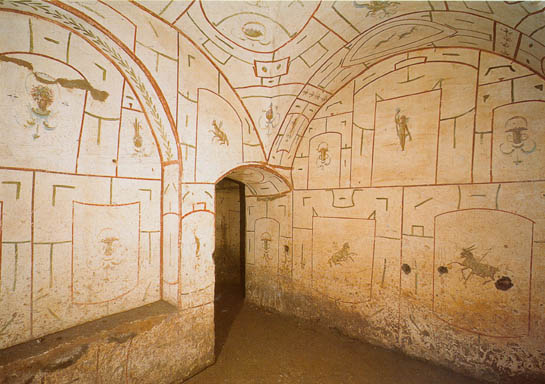
Over the course of time, St.
Sebastian, one of the martyrs buried here, ended up giving his name to the
cemetery that was originally called ad catacumbas, that is, “near
the depression”, because of the pozzolana quarries that existed at the site.
The toponym “catacomb” expanded later to indicate directly the Christian
underground cemeteries. The complex was also known as memoria
Apostolorum because the Apostles Saints Peter and Paul were venerated
there. Starting from the first century A.D., the site was used and built up
intensely. The galleries for extracting pozzolana were utilized again in order
to put both pagan and Christian tombs there in the form of loculi. Several
columbaria and at least two residential buildings were built (the “big villa”
and the “small villa”), with notable pictorial wall decorations. Around the
middle of the second century, the area of the quarries was covered over in
order to erect three mausoleums above it (of Clodius Hermes, of
the Innocentiores and of the Axe) in which Christians were
buried in the first half of the third century. After the area was covered over
again it created the surface on which to make the “trichlia”: a pergola or
trellis surrounded by a wall on which hundreds of graffiti have been deciphered
with invocations to Peter and Paul who were venerated here around the year 250
since it was impossible to go to their tombs in the Vatican and on the
Ostiense. On this spot, Emperor Constantine (306-337) later had a grandiose
basilica built in a circular form. In the meantime, starting from the third
century, the catacomb had already developed underground which housed the tombs
of the martyrs Sebastian and Eutichius. Throughout the Middle Ages, the complex
continued to be lively and visited. In the seventeenth century, Cardinal
Scipione Borghese had the current baroque basilica of St. Sebastian built which
is located in the central nave of the Constantine building.
CATACOMBS
OF DOMITILLA
Via delle Sette Chiese, 282 – 00147 ROME Phone: +39 06 51 103 42 / +39 06 51 33 956; Fax: +39 06 51 35 461 info@domitilla.info www.catacombe.domitilla.it Director: Brother Uwe Heisterhoff, SVD Closed Tuesdays Closed from mid-December to mid-January Bus ATAC: 714 |
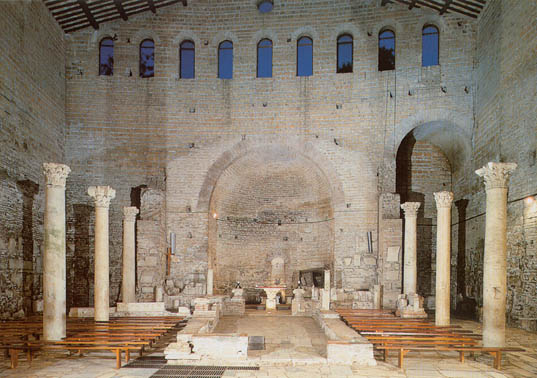
These catacombs extend along the
ancient Via Ardeatina on the site of the properties of the noblewoman Flavia
Domitilla, the niece of Flavio Clemente, a consul from 95 A .D., who married a niece
of Emperor Domitian (81-96) who was also called Flavia Domitilla. This part of
the gens Flavia apparently had Christian sympathies because we
know from the historians of the time that Domitian had Flavio Clemente
condemned to death for religious reasons, and that his wife and niece were
exiled to the Pontine Islands. Before their exile, the consul’s niece put her
possessions on the Ardeatina at the disposal of the Christian community where
the largest Christian underground cemetery of Rome would later originate.
The most important martyrs of the cemetery are Nereus and Achilleus, two soldiers who were probably victims of Diocletian’s persecution (304 A .D.). They were buried
in the basilica, a majestic apsed hall from the time of Pope Siricius
(385-399), which is preceded by a narthex and subdivided into three naves by columns
with reutilized capitals. Another very ancient nucleus is the hypogeum of the
Flavi. This originated at the end of the second century A.D. as a private,
pagan hypogeum which later, during the third century, housed Christian tombs
decorated with scenes from Sacred Scripture. The visit is complete with the
cubiculum of Veneranda, the arcosolium of the Little Apostles, and the
cubiculum of the grave-digger, Diogenes.
The most important martyrs of the cemetery are Nereus and Achilleus, two soldiers who were probably victims of Diocletian’s persecution (
CATACOMBS
OF PRISCILLA
Via Salaria, 430 – 00199 ROME Phone: +39 06 86 20 62 72 / +39 06 86 38 46 72; Fax: +39 06 86 39 81 34 info.priscilla@flashnet.it www.catacombedipriscilla.com Director: Father Joao Miguel Mendes Rodrigues Closed Mondays Closed in mid-July - mid-August Bus ATAC: 86, 92, 310 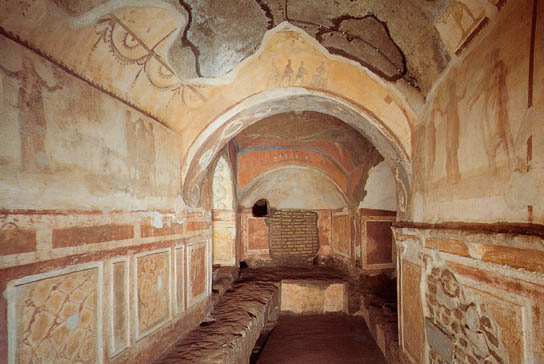 |
The noblewoman Priscilla was
probably the one who founded the cemetery or donated the area on which it
arose. As an inscription of the catacomb attests, Priscilla was related to the
noble gens Acilia. We know from the historians of the time that
Acilio Glabrione, a consul from 91
A .D., was condemned to death by Domitian, probably for
being a follower of Christ. The martyrs buried at Priscilla include the
brothers Felix and Philip, who were probably martyred under Diocletian,
together with their mother, St. Felicitas, and five other brothers: Alexander,
Martial, Vitale, Silano and Gennarus. Many popes were also buried at Priscilla:
Marcellinus (296-304), Marcellus (308-309), Sylvester (314-335), Liberius
(352-366), Siricius (384-399), Celestine (422-434) and Vigilius (537-555).
On the upper level the most important nuclei of the catacomb are located. The cubiculum of Velata is decorated with paintings from the second half of the third century representing the marriage, motherhood and death of the deceased woman in the cubiculum. The large niche of Our Lady with the Baby and the prophet Balaam (according to the prevailing identification) pointing to a star, represents the most ancient image of the Mother of God in the West (230-240). In the region of the central sandstone there is an ancient pozzolana quarry that was re-utilized in order to put poor loculi there closed by bricks with simple painted inscriptions. The cryptoportico with the Greek Chapel is a large underground masonry area that originated as a noble family burial ground that was later connected to the catacomb. The Greek Chapel owes its importance to the very ancient cycles of pictures decorating it (second half of the third century). In the hypogeum of the Acili, which was originally a water tank, the inscriptions of the Acili have been found and exhibited. Inside Villa Ada the basilica is found which Pope St. Sylvester had erected near the tomb of Felix and Philip.
On the upper level the most important nuclei of the catacomb are located. The cubiculum of Velata is decorated with paintings from the second half of the third century representing the marriage, motherhood and death of the deceased woman in the cubiculum. The large niche of Our Lady with the Baby and the prophet Balaam (according to the prevailing identification) pointing to a star, represents the most ancient image of the Mother of God in the West (230-240). In the region of the central sandstone there is an ancient pozzolana quarry that was re-utilized in order to put poor loculi there closed by bricks with simple painted inscriptions. The cryptoportico with the Greek Chapel is a large underground masonry area that originated as a noble family burial ground that was later connected to the catacomb. The Greek Chapel owes its importance to the very ancient cycles of pictures decorating it (second half of the third century). In the hypogeum of the Acili, which was originally a water tank, the inscriptions of the Acili have been found and exhibited. Inside Villa Ada the basilica is found which Pope St. Sylvester had erected near the tomb of Felix and Philip.
CATACOMBS
OF ST. AGNES
Via Nomentana, 349 – 00162 ROME Phone and Fax: +39 06 86 10 840 santagnese@santagnese.net www.santagnese.net Person in charge: Rev. Edoardo Parisotto Visiting hours: 9:00 – 12:00 / 4:00 – 6:00 p.m. Closed on Sunday and holiday mornings Closed in November Bus ATAC: 90, 60, 36 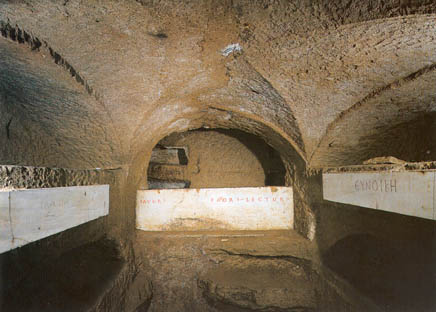 |
The famous and very young Roman
martyr Agnes was buried in this catacomb on the left side of Via Nomentana
where a hypogeum that belonged to her family probably already existed. We know
that Agnes died at just twelve years of age and underwent tremendous torments:
fire, according to Pope Damasus; decapitation, according to St. Ambrose and
Prudentius, while according to others, the veins in her neck were severed. As a
matter of fact, devotion to Agnes boomed right after her martyrdom. Roman and
foreign pilgrims visited her tomb. She was also venerated very much by Emperor
Constantine’s family. The Emperor’s daughter, Constantina (transformed by pious
legends into St. Costanza) had a grandiose circular basilica built near the
cemetery, of which only some masonry work remains today, and she wanted to be
buried near the saint. For this purpose she had a splendid cylindrical
mausoleum built, with a dome decorated inside by brightly colored mosaics with
cupids gathering grapes. Constantina was buried in a porphyry sarcophagus
(which is in the Vatican Museums today. A copy was put in the mausoleum).
On Agnes’ tomb in the catacomb, Pope Honorius I (625-638) had the present-day basilica built, which replaced a more ancient edifice from the time of Pope Symmachus (498-514). The basilica is partially below ground, with a narthex, three naves and a women’s gallery. The apse is decorated with a splendid mosaic representing Agnes between Popes Honorius and Symmachus. The catacomb is rather poorly preserved because it was visited without interruption over the course of the centuries.
On Agnes’ tomb in the catacomb, Pope Honorius I (625-638) had the present-day basilica built, which replaced a more ancient edifice from the time of Pope Symmachus (498-514). The basilica is partially below ground, with a narthex, three naves and a women’s gallery. The apse is decorated with a splendid mosaic representing Agnes between Popes Honorius and Symmachus. The catacomb is rather poorly preserved because it was visited without interruption over the course of the centuries.
CATACOMBS
OF St. MARCELLINO AND St. PIETRO
Via Casilina, 641 - 00177 ROMA Phone 06.2419446 - 339 6528887 santimarcellinoepietro@gmail.com www.santimarcellinoepietro.itPerson in charge:: Rev. Edmilson Mendes Visiting hours: Saturdays and Sundays at Booking in advance Bus ATAC 105; 409 Linea Tram Laziali/Giardinetti fermata "Berardi" 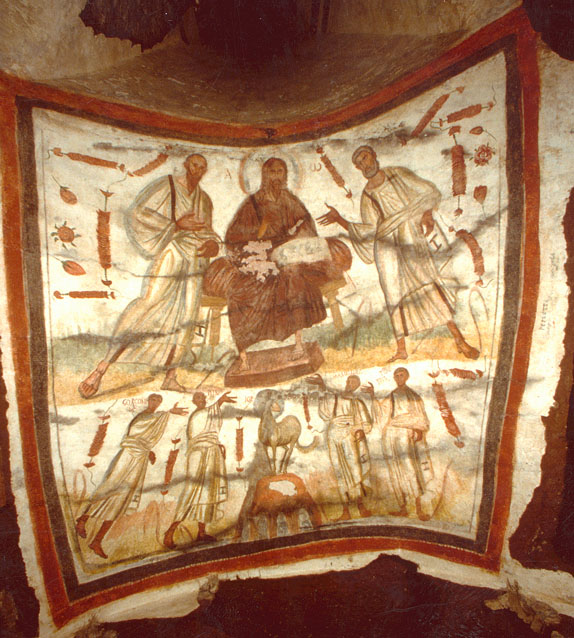 |
The
catacombs, dedicated to Saints Marcellinus and Peter, retain the tombs of the
two martyrs. You have to return to the times of the Emperor Diocletian to know
the history of life of the two martyrs. St. Marcellinus and St. Peter's were
slain in the persecution of 304 AD. They were beheaded in Rome White Forest
Catacombs of Latium open to the
public
ST.
CHRISTINA OF BOLSENA (VT)
For visits, please contact the Fathers of the Blessed Sacrament (“Sacramentini”) Parish of Sts. Martyrs George and Christina Piazza S. Cristina – 01023 Bolsena (VT) Phone and fax: +39 0761 79 90 67 info@basilicasantacristina.it www.basilicasantacristina.it Director: Father Domenico Marra Admission fee: full price € 4 – reduced price € 2 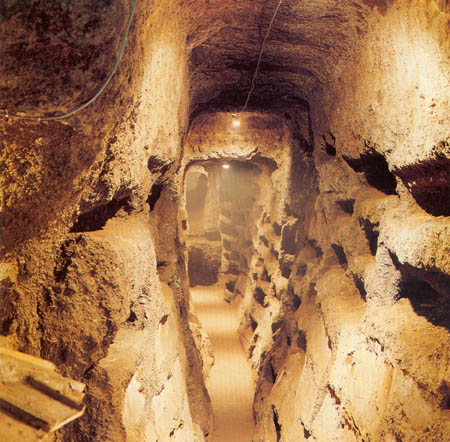 |
Catacomb of the fourth-fifth
century, attached to the medieval basilica of the martyr, with frescoes,
epigraphs (painted and marble) and an antique collection of objects from the
nineteenth century excavations of the monument.
ST. EUTIZIO
AT SORIANO NEL CIMINO (VT)
For visits, please contact the Passionist Fathers
Convent of St. Eutizio
Via del Convento, 18 – 01038 Soriano del Cimino (VT)
Phone: +39 0761 74 50 64
For visits, please contact the Passionist Fathers
Convent of St. Eutizio
Via del Convento, 18 – 01038 Soriano del Cimino (VT)
Phone: +39 0761 74 50 64
Fourth century catacomb attached
to the martyr’s basilica, with pictorial remains and personal items. The
presence of a niched tomb with frescoes depicting the Apostles Peter and Paul
is noteworthy.
ST.
SAVINILLA IN NEPI (VT)
For visits, contact the Civic Museum Palazzo Comunale Via XX Settembre – 01036 Nepi (VT) Phone: +39 0761 57 06 04 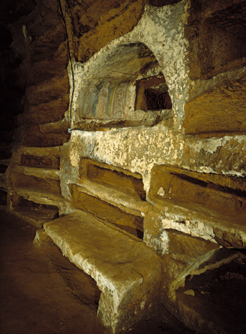 |
Catacomb from the fourth-fifth
century attached to the eighteenth century church named after Saints Tolomeus
and Romanus who, according to tradition, are buried in the underground
cemetery. The monument preserves painted inscriptions and graffiti, and
frescoes from late antiquity and the Middle Ages. Of note is the architectonic
system of the catacomb characterized by extremely wide, imposing galleries.
ST.
THEODORA AT RIGNANO FLAMINIO (RM)
For visits, please contact the City of Rignano Flaminio Palazzo Comunale Corso Umberto I, 17 – 00068 Rignano Flaminio (RM) Phone: +39 0761 50 91 43 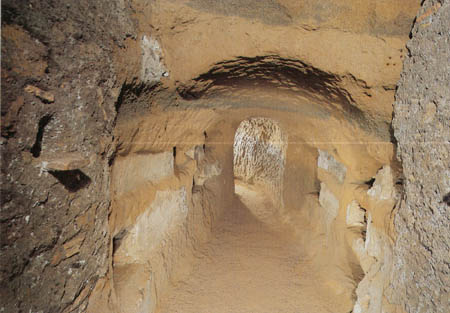 |
Catacomb from the fourth-fifth
century, remarkably wide, with many graffiti inscriptions on the tomb closings.
It is located in the area of Rignano’s modern cemetery on the 39th kilometer
of the Via Flaminia. It can be accessed from the eighteenth century cathedral
dedicated to St. Theodora and the martyrs of the catacomb (Abbondius,
Abbondantius, Marcianus and John).
MONTE STALLONE A FORMELLO (RM)For visits, please
contact Comune di Formello
Museo dell'Agro Veientano Piazza S. Lorenzo, 7 – 00060 Formello (RM) Tel. 06.90.194.240 Fax 06.90.89.577 e-mail museo@comunediformello.it Director: D.ssa Iefke Johanna van Kampen 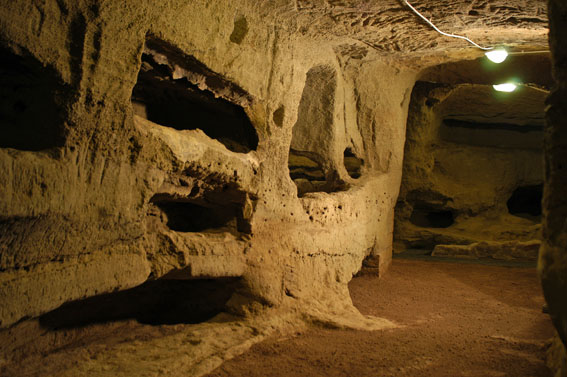 |
Discovery
in the 60s of last century, the catacomb is accessed from the east side of the
hill Monte Stallone. The Hypogeum has five short tunnels and a cubicle mainly
occupied by graves at burial niche; also the walk floor was used for burials.
The tombs were sealed by tiles or bricks and mortar and the wall surfaces were
coated with a layer of simple white or colored plaster. The general
characteristics of the monument refer to the fourth century, with a
continuity of life that reaches up to the fifth century.
ST.
VICTORIA AT MONTELEONE SABINO (RI)
For visits, please contact the “Guides of St. Victoria” Group Civic Museum Via Lucio Mummio, 11 – 02033 Monteleone Sabino (RI) Phone: +39 0765 88 40 14 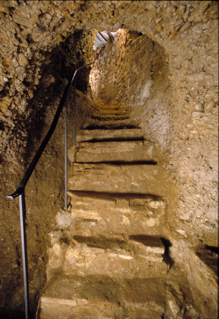 |
Fourth century catacomb attached
to the Romanesque church dedicated to the martyr. The cemetery was made in
pre-existing hydraulic and sandstone cavities excavated in the calcareous rock.
The catacomb is especially important for the particular funeral architecture
characterized by large masonry niches and series of tombs built one over the
other on several parallel planes.
ST.
SENATORE AT ALBANO (RM)
For visits, please contact the Diocesan Museum Palazzo Lercari Via Alcide De Gasperi, 37 Albano Laziale 00041 (RM) Director: Dott. Roberto Libera E-mail: info@robertolibera.it Tel. Uff. 0693269490 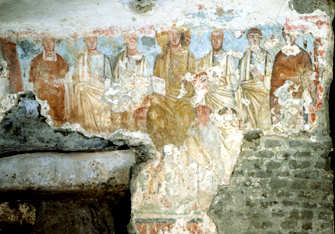 |
Catacomb from the late third to
the fifth century, which continued to be visited until the high Middle Ages as
a shrine of the martyr with the same name. Located at the Convent of the
Carmelite Fathers of S. Maria della Stella on the route of the ancient Appian
Way, the monument preserves an important series of Paleo-Christian and medieval
frescoes. The “historical crypt”, the center of devotion to the martyr
Senatore, has a remarkable monumental impact like the remaining part of the
cemetery entirely dug out in the areas of an ancient sandstone quarry which had
already housed a pagan funeral hypogeum in the first half of the third century.
CATACOMB AD
DECIMUM at Grottaferrata (RM)
For visits, please contact the Latin Archaeological Group Via del Castello, 33 – 00044 Frascati (RM) Phone: +39 06 94 19 665 Person in charge: Dr. Paolo Dalmiglio 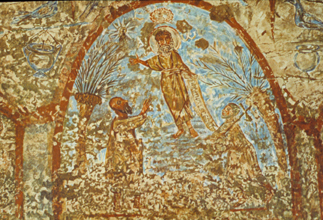 |
This catacomb, which is located
at the 16th kilometer of the Via Anagnina at Villa Senni
(Grottaferrata), dates back to the end of the third century and functioned
until the early decades of the fifth century. It appears to be quite extensive
and particularly important for the almost perfect state of preservation of some
of its sectors, as well as for the many frescoes and funeral inscriptions
preserved in it.
ST.
HILARY “AD BIVIUM” at Valmontone (RM)
For visits, please contact the Toleriense Archaeological Group Via dell’Artigianato, 9 – 00034 Colleferro (RM) Phone and fax: +39 06 97 81 169 Person in charge: Mr. Angelo Luttazzi |
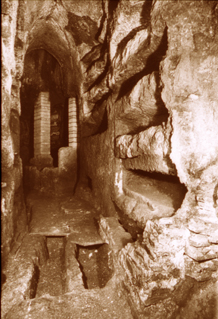
The catacomb is found in a rural
location (called “St. Hilary”) at the 30th mile of the ancient
Via Latina not far from the present-day centers of Colleferro and Valmontone.
The cemetery is made up of a good number of galleries and cubicula that have
given back epigraphic and ceramic materials (found today at the City Antiquarium
of Colleferro). In front of the catacomb an important open-pit cemetery lies
that is delimited by a fence which preserves many tombs in masonry or excavated
in the rock (fourth-fifth century). On this funeral area, at the end of the
eighth century, a small church stood (precisely the church of St. Hilary),
which represents one of the best preserved examples of high medieval buildings
for worship in Latium.
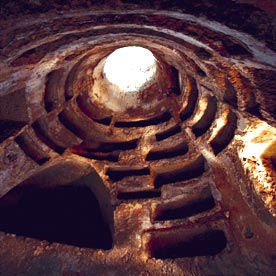
CATACOMB OF VIGNA CASSIA
Via A. von Platen, 34 – 96100 Siracusa
For visits (only by appointment), please contact:
Kairòs s.r.l.
Phone/fax: +39 0931 64694
pcas@catacombesiracusa.it
www.catacombesiracusa.it
Via A. von Platen, 34 – 96100 Siracusa
For visits (only by appointment), please contact:
Kairòs s.r.l.
Phone/fax: +39 0931 64694
pcas@catacombesiracusa.it
www.catacombesiracusa.it
The cemetery of Vigna Cassia is divided into three regions: Santa Maria di Gesù, Maggiore and Marcia. The first two originated around the third century, while the latter only began in the fourth century. The methods for re-utilizing the pre-existing hydraulics are in line with the early dating of the first two regions, and the genetic nucleus of the Maggiore cemetery was confirmed by the find inside one loculum of a hoard of coins issued under Gallienus and Claudius II the Goth. The paintings in one of the hypogea are noteworthy which constellate the vast concrete bed above the community cemetery. The M2 hypogeum has given back images that are still clear of an entirely Christian figurative subject in which two moments in particular can be distinguished from the trilogy of Jonah, Daniel in the lions’ den, and the resurrection of Lazarus.